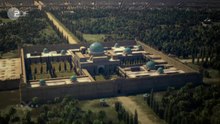Round city of Baghdad
Coordinates: 33 ° 20 ′ 55.7 ″ N , 44 ° 20 ′ 7 ″ E
The Round City of Baghdad ( Arabic مدينة بغداد المدورة, DMG Madīnat Baġdād al-mudawwara ; originally: City of Peace , Arabicمدينة السلام / Madīnat as-Salām ) is, according to the Islamic historian at-Tabarī, a city built by the Abbasid ruler al-Mansur from 762 in about five years with two circular fortification walls and four gates, in which the House of Wisdom was also located. The mosque and palace were in the middle. The location was u. a. chosen for traffic reasons. It was the new capital of the Islamic Empire, which later became Baghdad and flourished under new rulers.
There are various theories about the origin and meaning of the round shape, all of which agree that it should represent al-Mansur's claim to power. However, there are already tendencies towards circular systems in Sassanid urban planning.
Whether at-Tabarī's descriptions are correct is, however, controversial because there is no archaeological evidence of this city. It could be a legend and a reminiscence of the Roman city of Hatra , which had round fortification walls. The authenticity of the "round city" was suggested by a reconstructed plan by the archaeologist Ernst Herzfeld , which has been reproduced in numerous publications since the beginning of the 20th century, but is not based on finds, but exclusively on at-Tabarī's exact information. However, the city of ar-Rafiqa (today ar-Raqqa ), which was built in 772 on the model of the capital, has a verifiably round floor plan .
literature
- Volker Popp: From Ugarit to Samarra. An archaeological journey in the footsteps of Ernst Herzfeld. In: Karl-Heinz Ohlig (Ed.): Der early Islam, Berlin: Schiler 2007, p. 15 f.
- Jacob Lassner: The Caliph's Personal Domain: The City Plan of Baghdad Reexamined , in: Kunst des Orients , 5: 1968, Issue 1, pp. 24–36
Web links
- Al-Mansur's Round City of Baghdad on archnet.org
- Baghdad (Madinat al-Salam) on islamic-arts.org

